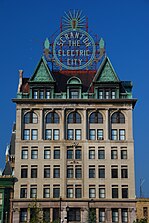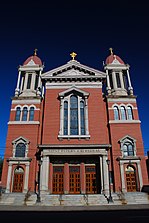Scranton, Pennsylvania
Scranton is a city in Pennsylvania. It is the county seat of Lackawanna County. The city had a population of 76,415 people in 2000.
City and County Seat | |||||||
| City of Scranton | |||||||
| |||||||
|
| |||||||
|
| |||||||
 Location of Scranton in Lackawanna County, Pennsylvania. | |||||||
| Coordinates: 41°24′38″N 75°40′03″W / 41.41056°N 75.66750°WCoordinates: 41°24′38″N 75°40′03″W / 41.41056°N 75.66750°W | |||||||
| Country | |||||||
| State | |||||||
| County | Lackawanna | ||||||
| Region | Greater Scranton | ||||||
| Incorporated (borough) | February 14, 1856 | ||||||
| Incorporated (city) | April 23, 1866 | ||||||
| Named for | George W. Scranton | ||||||
| Government | |||||||
| • Mayor | Paige Cognetti | ||||||
| Area | |||||||
| • City and County Seat | 25.54 sq mi (66.14 km2) | ||||||
| • Land | 25.31 sq mi (65.55 km2) | ||||||
| • Water | 0.23 sq mi (0.60 km2) | ||||||
| • Metro | 1,777 sq mi (4,602 km2) | ||||||
| Elevation | 745 ft (227 m) | ||||||
| Population | |||||||
| • City and County Seat | 76,089 | ||||||
| • Estimate (2018) | 77,182 | ||||||
| • Density | 3,066.42/sq mi (1,183.97/km2) | ||||||
| • Urban | 381,502 (US:99th) | ||||||
| • Metro | 562,037 (US:95th) | ||||||
| Time zone | UTC−05:00 (EST) | ||||||
| • Summer (DST) | UTC−04:00 (EDT) | ||||||
| ZIP Codes | 18447, 18501-18505, 18507-18510, 18512, 18514-18515, 18517-18519, 18522, 18540, 18577 | ||||||
| FIPS code | 42-69000 | ||||||
| Primary Airport | Wilkes-Barre/Scranton International Airport- AVP (Major/International) | ||||||
| Secondary Airport | Wilkes-Barre Wyoming Valley Airport- WBW (Minor) | ||||||
| Website | www | ||||||
History
Scranton was first settled in 1776 by Lenape Indians. Over time, settlers from New England began to move to Scranton. They built mills and other small businesses. The village was known as Slocum Hollow. In 1845, Scranton started to manufacture iron and steel. The iron was used for making rails. Scranton became a leading maker of iron rails. A railroad was founded in 1851. It was built to move iron and coal.
Scranton became a borough in 1856. In 1866, Scranton was made a city when Hyde Park and Providence joined together with the Borough of Scranton. The city had 35,000 people living in it. In 1866, a streetcar system was built. It was the first in the United States. Scranton got the nickname "The Electric City" because of this. In the late 1890s, Scranton had several minor league baseball teams.
The United States Census said that Scranton had a population of 102,026 people in the year 1900. This made it the 38th largest city in the United States. In the 1900s, Scranton was known for its many Victorian-style houses.
In 1901, the iron industry in Scranton moved to Lackawanna, New York. Scranton lost one of its main industries. In the next 25 years, many people from Eastern Europe moved to Scranton. Two years later, the Laurel Line railroad opened up, making it easy to go to Wilkes-Barre, 20 miles (32 km) south. After World War II, coal began losing cleaner fuels such as oil and gas. This caused Scranton to diminish. There wasn't as much coal being made, and not as many trains passed through. The streetcar system stopped in 1954, and a year later, the city was flooded after Hurricane Diane. 80 people died. The NYO&W freight railroad stopped going to Scranton in 1957.
The Knox Mine Disaster of 1959 wiped out the mining industry as the Susquehanna River flooded most of the mines in Northeastern Pennsylvania. The local DL&W railroad, nearly out of money, merged with the Erie Railroad in 1960. In the 1960s and 1970s, the silk and textile industries was getting smaller as they moved South or overseas. In the 1970s and 1980s, the downtown shops lay empty as it was best to shop in suburban malls. However, in the 1980s, the people of Scranton started revitalizing the city. Old places were marketed as tourist attractions. There is a historic site commemorating the city's railroad history, a hotel at the former DL&W Railroad station and a trolley museum. Some more modern attractions are a ski resort, the Scranton/Wilkes-Barre Yankees (a minor league baseball team) and a concert venue. Also, popular sitcom The Office is set in Scranton.
References
- ↑ "2017 U.S. Gazetteer Files". United States Census Bureau. Retrieved Mar 24, 2019.
- ↑ "Population Estimates". United States Census Bureau. Archived from the original on 2014-05-22. Retrieved 2014-06-11.




